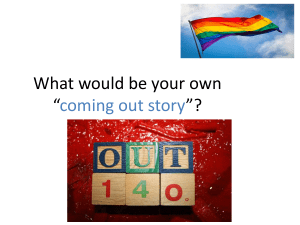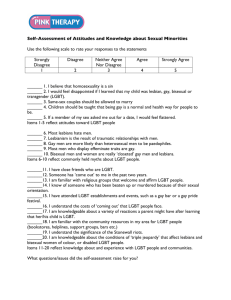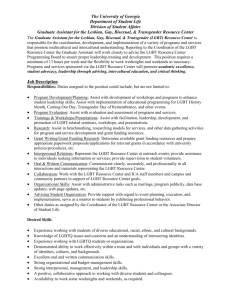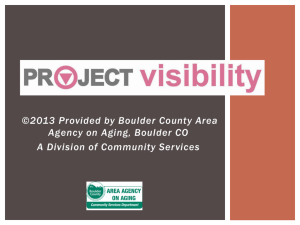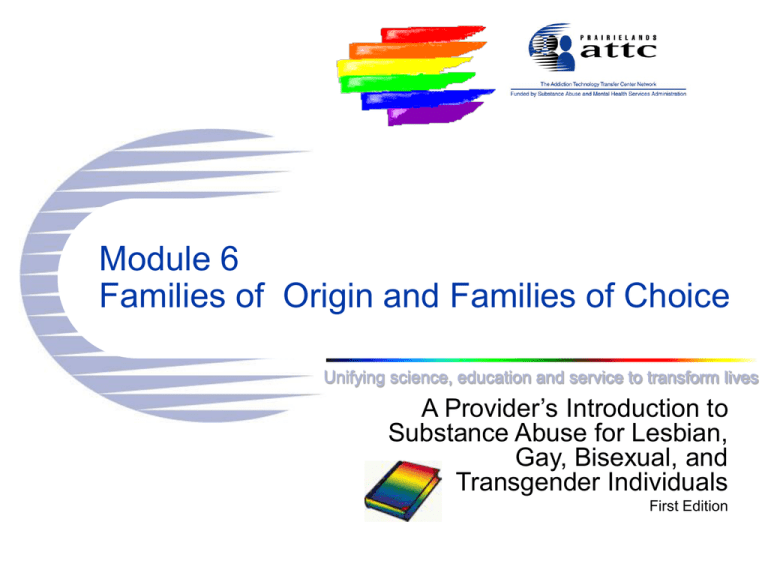
Module 6
Families of Origin and Families of Choice
A Provider’s Introduction to
Substance Abuse for Lesbian,
Gay, Bisexual, and
Transgender Individuals
First Edition
Unifying science, education and services to transform lives.
Families of Origin
and Families of Choice
Learning Objectives
Understand families of
origin versus families of
choice
Understand family-related
relapse triggers
Be able to develop
interventions for families
of choice in treatment
Power Point Slide # 6-1, n11
A Provider’s Introduction to Substance Abuse for LGBT Individuals
Clinicians Guide, Part 2 of 2
Unifying science, education and services to transform lives.
Family Influences
1.
What are the important values and major
influences, positive and negative, that you
received from your families while growing up?
2.
How do these family influences affect our
lives?
3.
How might all of these family values and
influences affect a client’s relapse patterns
and/or recovery?
Power Point Slide #6-2, n12
A Provider’s Introduction to Substance Abuse for LGBT Individuals
Clinicians Guide, Part 2 of 2
Unifying science, education and services to transform lives.
Definition of Family of Origin
The birth or biological family or any
family system instrumental or
significant in a client’s early
development
Power Point Slide # 6-3, n13
A Provider’s Introduction to Substance Abuse for LGBT Individuals
Clinicians Guide, Part 2 of 2
Unifying science, education and services to transform lives.
Taking a Family History
All Clients:
What were the rules of the
family system?
Was there a history of
physical, emotional, spiritual,
or sexual trauma?
Were all family members
expected to behave or evolve
in a certain way?
What were the family’s
expectations in regard to
careers, relationships,
appearance, status, or
environment?
In general, was sex ever
discussed?
LGBT Clients:
Was anyone else in the family
acknowledged to be or
suspected of being a lesbian,
gay, bisexual, or transgender
individual?
How did the family respond to
other individuals coming out or
being identified as LGBT
individuals?
Is the client out to his or her
family?
If the client is out, what type of
response did he or she
receive?
Power Point Slide # 6-4, n14
A Provider’s Introduction to Substance Abuse for LGBT Individuals Clinician’s Guide: Part 2 of 2
Unifying science, education and services to transform lives.
Definition: Families of Choice
LGBT people create "replacement" family
networks that are made up of individuals who
are significant to them, including:
♥
♥
♥
♥
♥
♥
friends
partners
families of partners
ex-lovers
blood relatives
individuals who have died or are no longer an
immediate part of the client’s life because of
addiction, HIV/AIDS, a relationship break-up, or
other life events.
Power Point Slide #6-5, n15
A Provider’s Introduction to Substance Abuse for LGBT Individuals
Clinicians Guide, Part 2 of 2
Unifying science, education and services to transform lives.
Guidelines for Working With
LGBT Families
Demonstrate support
and understanding for
the life partners and
significant others
Be sensitive to the
individual’s selfidentification
Be sensitive to the
diversity and variety of
relationships in the
LGBT community
No universal
terminology regarding
significant others in
the LGBT community
Be careful of biases
re: what a family
should be
Do not assume there
is no history of
opposite-sex
relationships
Power Point Slide # 6-6, n16
A Provider’s Introduction to Substance Abuse for LGBT Individuals
Clinicians Guide, Part 2 of 2
Unifying science, education and services to transform lives.
Myth: Lesbians and gay men do not have
children.
Fact: The American Bar Association estimates that
at least 6 to 10 million daughters and sons of
lesbian, gay, and bisexual parents in the United
States.
Power Point Slide # 6-7, n17
A Provider’s Introduction to Substance Abuse for LGBT Individuals
Clinicians Guide, Part 2 of 2
Unifying science, education and services to transform lives.
Myth: Children raised by LGBT parents are
likely to turn out to be LGBT themselves.
Fact: Published studies have established that
children raised by gay or lesbian parents are
no more likely to grow up gay or lesbian than
other children (Patterson 1992).
Power Point Slide # 6-8, n18
A Provider’s Introduction to Substance Abuse for LGBT Individuals
Clinicians Guide, Part 2 of 2
Unifying science, education and services to transform lives.
Myth: Children who are in contact with gay men or
lesbians face increased risk of being sexually
abused.
Fact: Statistics indicate that 90% of all children sexual
abuse cases involve a heterosexual male
perpetrator .
Myth: Gay men and lesbians have unstable
relationships that make them inadequate parents.
Fact: A large number of gay men and lesbians can and do
enjoy long stable and satisfying relationships.
Power Point Slide # 6-9, n19
A Provider’s Introduction to Substance Abuse for LGBT Individuals
Clinicians Guide, Part 2 of 2
Unifying science, education and services to transform lives.
Myth: The only acceptable home for a child contains a
mother and father who are married to each other.
Fact: The reality of today is that the traditional definition
of the married, heterosexual couple with 1.5 children is
only one of many types of families that children grow
and thrive in.
Myth: Children raised by a gay or lesbian couple will
not have proper male and female role models.
Fact: Research suggests that children of LGBT parents
are exposed to more people of the opposite sex
than many children of straight parents and even
when children are not, there is no evidence to suggest
that they are harmed (Kirkpatrick 1987).
Power Point Slide # 6-10, n20
A Provider’s Introduction to Substance Abuse for LGBT Individuals
Clinicians Guide, Part 2 of 2

